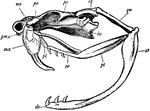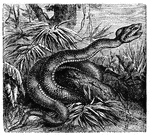Search for "fang"

Common Vipers
"Viper is a genus of venomous snakes. This family includes many important forms– e. g., the common…

Common Viper
"Viper is a genus of venomous snakes. This family includes many important forms– e. g., the common…

Rattlesnake Skull
This illustration shows the skull of a rattlesnake. ar, articular portion of lower jaw; de, dentary…

The Teeth
Characteristics of the teeth. Teach tooth consists of a crown or body, projecting above the gum; root…

Structure of the Teeth
Structure of the teeth. A tooth consists of 3 structures, the dentine (2), or ivory, the proper dental…

Snake Head
"Snake's head. dv., Poison fangs; b., sheath of fang; l., tongue; rl., muscles of tongue." -Thomson,…

Rattlesnake Poison Apparatus
"Poison apparatus of rattlesnake. A, eye; Gc, poison-duct entering the poison-fang at +; Km, muscles…

Fer-de-Lance
"The Viperine Snakes have a long, perforated, erectile fang on the maxillary bone, which is extremely…
Dock Spike
"A large nail or pin, generally of iron. The larger forms of spikes, particularly railroad spikes, are…
Cut Spike
"A large nail or pin, generally of iron. The larger forms of spikes, particularly railroad spikes, are…

Railway Spikes
"A large nail or pin, generally of iron. The larger forms of spikes, particularly railroad spikes, are…
Barbed Spike
"A large nail or pin, generally of iron. The larger forms of spikes, particularly railroad spikes, are…
Barbed and Forked Spike
"A large nail or pin, generally of iron. The larger forms of spikes, particularly railroad spikes, are…

Forked Spikes
"A large nail or pin, generally of iron. The larger forms of spikes, particularly railroad spikes, are…